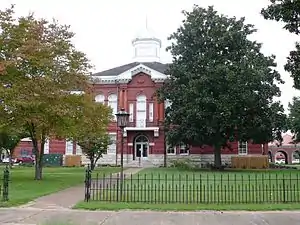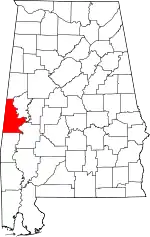Livingston, Alabama
Livingston is a city in Sumter County, Alabama, United States. By an act of the state legislature, it was incorporated on January 10, 1835.[3] At the 2010 census the population was 3,485, up from 3,297 in 2000. The city is the county seat of Sumter County,[4] and the home of the University of West Alabama. It was named in honor of Edward Livingston, of the Livingston family of New York.[5]
Livingston, Alabama | |
|---|---|
| City of Livingston | |
 The Sumter County Courthouse in Livingston, Alabama | |
 Location of Livingston in Sumter County, Alabama. | |
| Coordinates: 32°35′14″N 88°11′17″W | |
| Country | United States |
| State | Alabama |
| County | Sumter |
| Government | |
| • Mayor | Tom Tartt |
| Area | |
| • Total | 7.21 sq mi (18.68 km2) |
| • Land | 7.13 sq mi (18.47 km2) |
| • Water | 0.08 sq mi (0.22 km2) |
| Elevation | 154 ft (47 m) |
| Population (2010) | |
| • Total | 3,485 |
| • Estimate (2019)[2] | 3,260 |
| • Density | 457.22/sq mi (176.54/km2) |
| Time zone | UTC-6 (Central (CST)) |
| • Summer (DST) | UTC-5 (CDT) |
| ZIP code | 35470 |
| Area code(s) | 205, 659 |
| FIPS code | 01-43720 |
| GNIS feature ID | 0152129 |
| Website | https://www.cityoflivingstonal.com/ |
Geography
Livingston is located at 32°35′14″N 88°11′17″W (32.587332, -88.188161).[6]
According to the U.S. Census Bureau, the city has a total area of 7.2 square miles (19 km2), of which 7.1 square miles (18 km2) is land and 0.1 square miles (0.26 km2) (1.11%) is water.
Demographics
| Historical population | |||
|---|---|---|---|
| Census | Pop. | %± | |
| 1870 | 500 | — | |
| 1880 | 738 | 47.6% | |
| 1890 | 850 | 15.2% | |
| 1900 | 851 | 0.1% | |
| 1910 | 877 | 3.1% | |
| 1920 | 968 | 10.4% | |
| 1930 | 1,072 | 10.7% | |
| 1940 | 1,170 | 9.1% | |
| 1950 | 1,681 | 43.7% | |
| 1960 | 1,544 | −8.1% | |
| 1970 | 2,358 | 52.7% | |
| 1980 | 3,187 | 35.2% | |
| 1990 | 3,530 | 10.8% | |
| 2000 | 3,297 | −6.6% | |
| 2010 | 3,485 | 5.7% | |
| 2019 (est.) | 3,260 | [2] | −6.5% |
| U.S. Decennial Census[7] 2013 Estimate[8] | |||
As of the 2010 United States Census, there were 3,485 people living in the city. 63.8% were African American, 34.4% White, 0.1% Native American, 0.3% Asian, <0.1% Pacific Islander and 0.6% of two more races. 0.7% were Hispanic or Latino of any race.
As of the census[9] of 2000, there were 3,297 people, 1,368 households, and 731 families living in the city. The population density was 463.1 people per square mile (178.8/km2). There were 1,586 housing units at an average density of 222.8 per square mile (86.0/km2). The racial makeup of the city was 60.78% Black or African American, 37.82% White or Caucasian, 0.18% Asian, 0.15% Native American, 0.30% from other races, and 0.76% from two or more races. 1.43% of the population were Hispanic or Latino of any race.
Of the 1,368 households, 29.4% had children under the age of 18 living with them, 30.0% were married couples living together, 20.2% had a female householder with no husband present, and 46.5% were non-families. 35.5% of all households were made up of individuals, and 10.8% had someone living alone who was 65 years of age or older. The average household size was 2.31 and the average family size was 3.14.
In the city, the population was spread out, with 26.2% under the age of 18, 23.7% from 18 to 24, 24.2% from 25 to 44, 16.5% from 45 to 64, and 9.4% over the age of 65. The median age was 25 years. For every 100 females, there were 85.9 males. For every 100 females aged 18 and higher, there were 78.0 males.
The median income for a household in the city was $13,516, and the median income for a family was $22,500. Males had a median income of $31,838 as opposed to $20,833 for females. The per capita income for the city was $11,640. About 39.4% of families and 46.1% of the population were below the poverty line, including 53.4% of those under age 18 and 26.0% of those aged 65 years or more.
History
The area now known as Livingston was part of the traditional territory of the nation of Choctaw Indians until the Treaty of Dancing Rabbit Creek in 1830. The federal government removed most of the Choctaw to Indian Territory in present-day Oklahoma. At that time, settlers from the Carolinas, Georgia, Tennessee, and Virginia established the first European-American community about two blocks from the current Courthouse Square, near the corner of Madison and Spring Streets.
In 1833, a commission was formed to organize Sumter County. Livingston was named after a well-known statesman and jurist of the day, Edward Livingston.[5] Livingston was chosen as the county seat. Soon followed the first newspaper, The Voice of Sumter; four schools (including Livingston Female Academy, now The University of West Alabama), the courthouse, and the Bored Well.
The first courthouse was built of logs. It was replaced by a frame courthouse in 1839, which burned in 1901. The Probate Judge's office, built at the same time, survived the fire. It now houses the county commission office.
In the latter part of the nineteenth century, Livingston became widely known as a health spa because of the water from its Bored Well, one of many that made extensive settlement possible in the Black Belt. This well was bored by an old blind mule which pulled an auger around until an artesian aquifer was reached in 1857. Promoters built a Chinese-styled pagoda over the wall. In 1924 the pagoda was replaced by the predecessor to the present pavilion.
During the early part of the twentieth century, Livingston continued to be known as a health resort. It was also the site of the Alabama Normal School, which developed from the Livingston Female Academy and was established to train teachers for the public school system founded during the Reconstruction era. Reflecting its expanding programs and level of curriculum, the name of the college was later changed to the State Teachers College, then to Livingston State College, Livingston University and finally to The University of West Alabama.
Livingston continued as the sleepy county seat of a mainly rural county, with a declining population. In the early 1960s, citizens made an effort to revitalize the town, building on their historic heritage and main street. The results were a near doubling in population in ten years, and corresponding increase in industry and businesses. In 1972 Livingston was named a finalist in the "All American Cities Competition", sponsored by The Saturday Evening Post.
Historic sites
Livingston has a number of historic sites and properties. Lakewood (1840) is a historic antebellum mansion occupied by Julia Tutwiler while she was president of Livingston Normal College.[10] The Sumter County Courthouse (1902) is listed on the National Register of Historic Places.[11] Additionally, the Branch-Stuart Home (1903), Inge-Moon House (1834), St. James Episcopal Church (1840), and Voss-Pate House (1850) are all listed on the Alabama Register of Landmarks and Heritage.[12]
Education
University of West Alabama is in Livingston.
Sumter County School District operates public schools serving Livingston: Livingston Junior High School and Sumter Central High School. It was previously served by Livingston High School until it merged into Sumter Central High in 2011.[13] In addition there is a charter school on the campus of the University of West Alabama in Livingston, University Charter School.[14]
Sumter Academy, a private school, was in an unincorporated area near York.[15] It closed in 2017.[16]
Notable people
- Richard Arrington, Jr., first African American mayor of Birmingham, Alabama
- Mario Austin, professional basketball player
- Willis Brewer, former U.S. Representative from Alabama
- Nathan Elams Cockrell, a founder of Sigma Alpha Epsilon fraternity
- Vera Hall, folk singer
- Ken Hutcherson, NFL Player for the Dallas Cowboys, the San Diego Chargers, the Green Bay Packers, and the Kansas City Chiefs
- Bob Simmons, head coach at Oklahoma State from 1995 to 2000
References
- "2019 U.S. Gazetteer Files". United States Census Bureau. Retrieved June 29, 2020.
- "Population and Housing Unit Estimates". United States Census Bureau. May 24, 2020. Retrieved May 27, 2020.
- http://www.toursumtercounty.com/sumter-county-towns/livingston-alabama/
- "Find a County". National Association of Counties. Retrieved 2011-06-07.
- "History". City of Livingston. Archived from the original on September 1, 2012. Retrieved September 27, 2012.
- "US Gazetteer files: 2010, 2000, and 1990". United States Census Bureau. 2011-02-12. Retrieved 2011-04-23.
- "U.S. Decennial Census". Census.gov. Retrieved June 6, 2013.
- "Annual Estimates of the Resident Population: April 1, 2010 to July 1, 2013". Archived from the original on May 22, 2014. Retrieved June 3, 2014.
- "U.S. Census website". United States Census Bureau. Retrieved 2008-01-31.
- Gamble, Robert (1987). The Alabama Catalog: A Guide to the Early Architecture of the State. University, AL: University of Alabama Press. p. 343. ISBN 0-8173-0148-8.
- "National Register Information System". National Register of Historic Places. National Park Service. April 15, 2008.
- "The Alabama Register of Landmarks & Heritage". preserveala.org. Alabama Historical Commission. April 4, 2012. Archived from the original (PDF) on May 10, 2012. Retrieved April 30, 2012.
- Williams, Andrea (2011-08-09). "Students Attend First Day at Sumter Central High". WTOK. Retrieved 2019-01-15.
- "About." University Charter School. Retrieved on January 15, 2019.
- Home. Sumter Academy. Retrieved on January 15, 2019. "181 Sumter Academy Road York, Alabama 36925"
- Taylor, Drew (June 21, 2017). "Sumter Academy shuts down following dwindling enrollment". Tuscaloosa News. Retrieved 13 January 2018.
